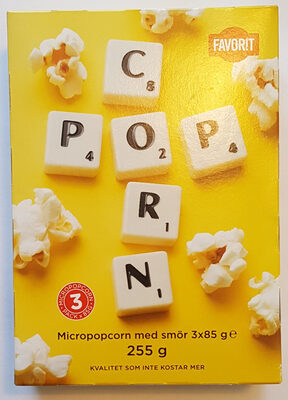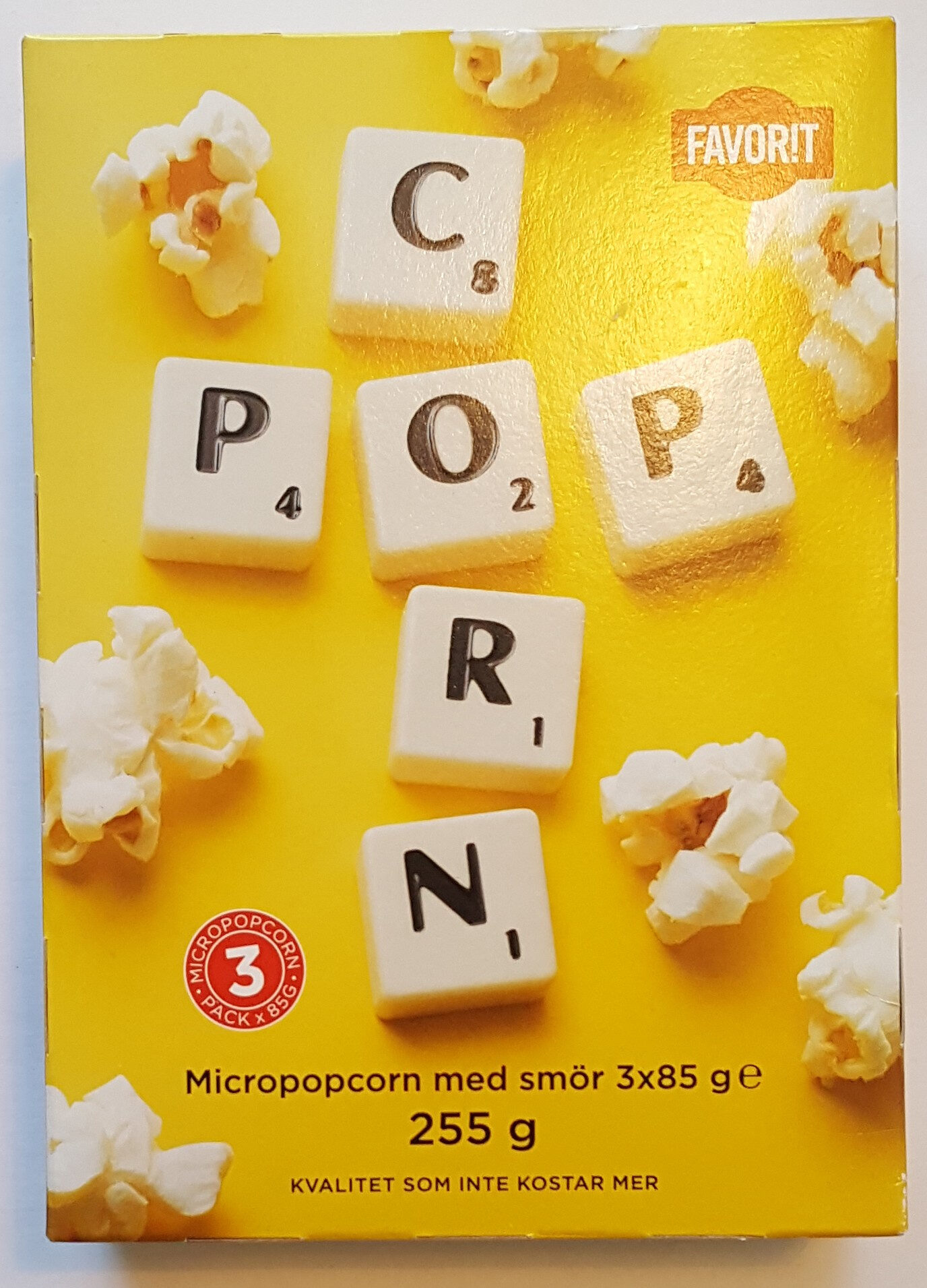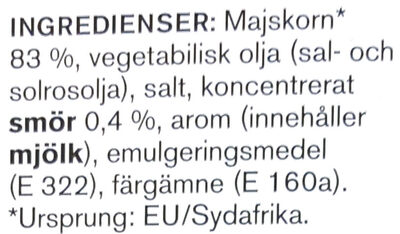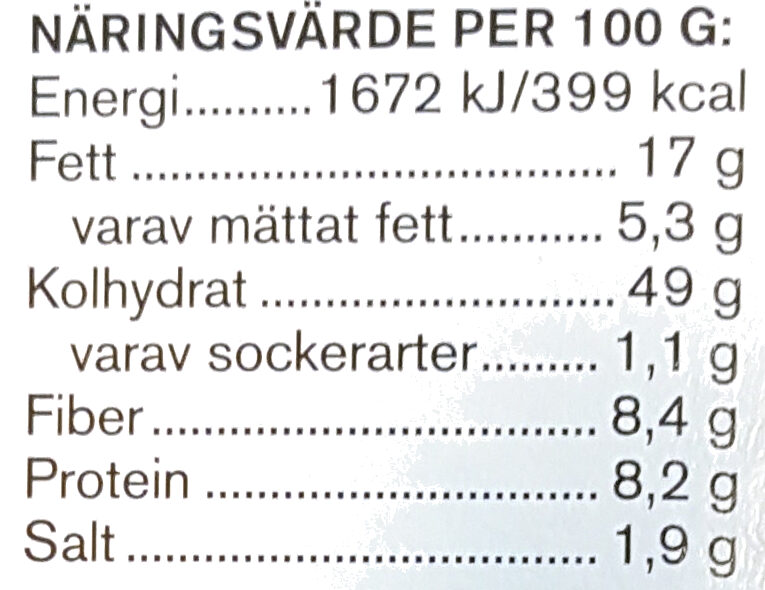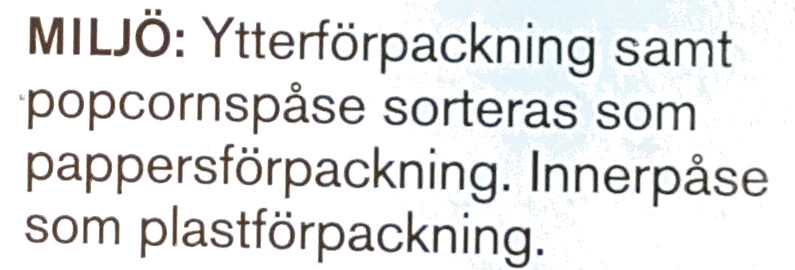Help us make food transparency the norm!
As a non-profit organization, we depend on your donations to continue informing consumers around the world about what they eat.
The food revolution starts with you!
Micropopcorn med smör - Favorit - 255 g
Micropopcorn med smör - Favorit - 255 g
Streckkod: 7331746164644 (EAN / EAN-13)
Kvantitet: 255 g
Förpackning: Papper, Kartong, en:container
Varumärken: Favorit
Kategorier: Snacks, Salta snacks, en:Popcorn, en:Salted popcorn
Etiketter, certifieringar, utmärkelser:
en:FSC, en:FSC Mix, en:FSC 016368
Ingredients ursprung: Europeiska unionen, Sydafrika
Butiker: City Gross
Länder där såld: Sverige
Matching with your preferences
Hälsa
Ingredienser
-
11 ingredienser
Majskorn 83 %, vegetabilisk olja (sal - och solrosolja), salt, koncentrerat smör 0,4 %, arom (innehåller mjölk), emulgeringsmedel (E 322), färgämne (E 160a).Allergener: Mjölk
Food processing
-
Ultra processed foods
Elements that indicate the product is in the 4 - Ultra bearbetade livsmedel och drycker group:
- Tillsats: E160a - Karoten
- Tillsats: E322 - Lecitiner
- Ingrediens: Färg
- Ingrediens: Emulgeringsmedel
- Ingrediens: Arom
Food products are classified into 4 groups according to their degree of processing:
- Obearbetade eller minimalt bearbetade livsmedel
- Bearbetade kulinariska ingredienser
- Halvfabrikat
- Ultra processed foods
The determination of the group is based on the category of the product and on the ingredients it contains.
Tillsatser
-
E160a - Karoten
Carotene: The term carotene -also carotin, from the Latin carota, "carrot"- is used for many related unsaturated hydrocarbon substances having the formula C40Hx, which are synthesized by plants but in general cannot be made by animals -with the exception of some aphids and spider mites which acquired the synthesizing genes from fungi-. Carotenes are photosynthetic pigments important for photosynthesis. Carotenes contain no oxygen atoms. They absorb ultraviolet, violet, and blue light and scatter orange or red light, and -in low concentrations- yellow light. Carotenes are responsible for the orange colour of the carrot, for which this class of chemicals is named, and for the colours of many other fruits, vegetables and fungi -for example, sweet potatoes, chanterelle and orange cantaloupe melon-. Carotenes are also responsible for the orange -but not all of the yellow- colours in dry foliage. They also -in lower concentrations- impart the yellow coloration to milk-fat and butter. Omnivorous animal species which are relatively poor converters of coloured dietary carotenoids to colourless retinoids have yellowed-coloured body fat, as a result of the carotenoid retention from the vegetable portion of their diet. The typical yellow-coloured fat of humans and chickens is a result of fat storage of carotenes from their diets. Carotenes contribute to photosynthesis by transmitting the light energy they absorb to chlorophyll. They also protect plant tissues by helping to absorb the energy from singlet oxygen, an excited form of the oxygen molecule O2 which is formed during photosynthesis. β-Carotene is composed of two retinyl groups, and is broken down in the mucosa of the human small intestine by β-carotene 15‚15'-monooxygenase to retinal, a form of vitamin A. β-Carotene can be stored in the liver and body fat and converted to retinal as needed, thus making it a form of vitamin A for humans and some other mammals. The carotenes α-carotene and γ-carotene, due to their single retinyl group -β-ionone ring-, also have some vitamin A activity -though less than β-carotene-, as does the xanthophyll carotenoid β-cryptoxanthin. All other carotenoids, including lycopene, have no beta-ring and thus no vitamin A activity -although they may have antioxidant activity and thus biological activity in other ways-. Animal species differ greatly in their ability to convert retinyl -beta-ionone- containing carotenoids to retinals. Carnivores in general are poor converters of dietary ionone-containing carotenoids. Pure carnivores such as ferrets lack β-carotene 15‚15'-monooxygenase and cannot convert any carotenoids to retinals at all -resulting in carotenes not being a form of vitamin A for this species-; while cats can convert a trace of β-carotene to retinol, although the amount is totally insufficient for meeting their daily retinol needs.Källa: Wikipedia (Engelska)
-
E322 - Lecitiner
Lecithin: Lecithin -UK: , US: , from the Greek lekithos, "egg yolk"- is a generic term to designate any group of yellow-brownish fatty substances occurring in animal and plant tissues, which are amphiphilic – they attract both water and fatty substances -and so are both hydrophilic and lipophilic-, and are used for smoothing food textures, dissolving powders -emulsifying-, homogenizing liquid mixtures, and repelling sticking materials.Lecithins are mixtures of glycerophospholipids including phosphatidylcholine, phosphatidylethanolamine, phosphatidylinositol, phosphatidylserine, and phosphatidic acid.Lecithin was first isolated in 1845 by the French chemist and pharmacist Theodore Gobley. In 1850, he named the phosphatidylcholine lécithine. Gobley originally isolated lecithin from egg yolk—λέκιθος lekithos is "egg yolk" in Ancient Greek—and established the complete chemical formula of phosphatidylcholine in 1874; in between, he had demonstrated the presence of lecithin in a variety of biological matters, including venous blood, in human lungs, bile, human brain tissue, fish eggs, fish roe, and chicken and sheep brain. Lecithin can easily be extracted chemically using solvents such as hexane, ethanol, acetone, petroleum ether, benzene, etc., or extraction can be done mechanically. It is usually available from sources such as soybeans, eggs, milk, marine sources, rapeseed, cottonseed, and sunflower. It has low solubility in water, but is an excellent emulsifier. In aqueous solution, its phospholipids can form either liposomes, bilayer sheets, micelles, or lamellar structures, depending on hydration and temperature. This results in a type of surfactant that usually is classified as amphipathic. Lecithin is sold as a food additive and dietary supplement. In cooking, it is sometimes used as an emulsifier and to prevent sticking, for example in nonstick cooking spray.Källa: Wikipedia (Engelska)
Ingrediensanalys
-
Kan innehålla palmolja
Ingredienser som kan innehålla palmolja: Smörfett, E160a
-
Icke-vegan
Non-vegan ingredients: SmörfettVissa ingredienser kunde inte kännas igen.
Vi behöver din hjälp!
You can help us recognize more ingredients and better analyze the list of ingredients for this product and others:
- Edit this product page to correct spelling mistakes in the ingredients list, and/or to remove ingredients in other languages and sentences that are not related to the ingredients.
- Add new entries, synonyms or translations to our multilingual lists of ingredients, ingredient processing methods, and labels.
If you would like to help, join the #ingredients channel on our Slack discussion space and/or learn about ingredients analysis on our wiki. Thank you!
-
Vegetarisk status okänd
Okända ingredienser: Sal, Och-solrosoljaVissa ingredienser kunde inte kännas igen.
Vi behöver din hjälp!
You can help us recognize more ingredients and better analyze the list of ingredients for this product and others:
- Edit this product page to correct spelling mistakes in the ingredients list, and/or to remove ingredients in other languages and sentences that are not related to the ingredients.
- Add new entries, synonyms or translations to our multilingual lists of ingredients, ingredient processing methods, and labels.
If you would like to help, join the #ingredients channel on our Slack discussion space and/or learn about ingredients analysis on our wiki. Thank you!
-
Details of the analysis of the ingredients
Vi behöver din hjälp!
Vissa ingredienser kunde inte kännas igen.
Vi behöver din hjälp!
You can help us recognize more ingredients and better analyze the list of ingredients for this product and others:
- Edit this product page to correct spelling mistakes in the ingredients list, and/or to remove ingredients in other languages and sentences that are not related to the ingredients.
- Add new entries, synonyms or translations to our multilingual lists of ingredients, ingredient processing methods, and labels.
If you would like to help, join the #ingredients channel on our Slack discussion space and/or learn about ingredients analysis on our wiki. Thank you!
: Majskorn 83%, vegetabilisk olja (sal, och solrosolja), salt, koncentrerat _smör_ 0.4%, arom, emulgeringsmedel (e322), färgämne (e160a)- Majskorn -> en:corn-kernel - vegan: yes - vegetarian: yes - ciqual_food_code: 9200 - percent_min: 83 - percent: 83 - percent_max: 83
- vegetabilisk olja -> en:vegetable-oil - vegan: yes - vegetarian: yes - from_palm_oil: maybe - percent_min: 13.5 - percent_max: 16.2
- sal -> sv:sal - percent_min: 6.75 - percent_max: 16.2
- och solrosolja -> sv:och-solrosolja - percent_min: 0 - percent_max: 8.1
- salt -> en:salt - vegan: yes - vegetarian: yes - ciqual_food_code: 11058 - percent_min: 0.4 - percent_max: 1.9
- koncentrerat _smör_ -> en:butterfat - vegan: no - vegetarian: yes - from_palm_oil: maybe - ciqual_food_code: 16401 - percent_min: 0.4 - percent: 0.4 - percent_max: 0.4
- arom -> en:flavouring - vegan: maybe - vegetarian: maybe - percent_min: 0 - percent_max: 0.4
- emulgeringsmedel -> en:emulsifier - percent_min: 0 - percent_max: 0.4
- e322 -> en:e322 - vegan: maybe - vegetarian: maybe - percent_min: 0 - percent_max: 0.4
- färgämne -> en:colour - percent_min: 0 - percent_max: 0.4
- e160a -> en:e160a - vegan: maybe - vegetarian: maybe - from_palm_oil: maybe - percent_min: 0 - percent_max: 0.4
Näring
-
Poor nutritional quality
This product is not considered a beverage for the calculation of the Nutri-Score.
Positiva poäng: 5
- Proteiner: 5 / 5 (värde: 8.2, avrundat värde: 8.2)
- Fiber: 5 / 5 (värde: 8.4, avrundat värde: 8.4)
- Frukt, grönsaker, nötter och raps- / valnöt- / olivoljor: 0 / 5 (värde: 0, avrundat värde: 0)
Negativa poäng: 17
- Energi: 4 / 10 (värde: 1672, avrundat värde: 1672)
- Socker: 0 / 10 (värde: 1.1, avrundat värde: 1.1)
- Mättat fett: 5 / 10 (värde: 5.3, avrundat värde: 5.3)
- Natrium: 8 / 10 (värde: 760, avrundat värde: 760)
The points for proteins are not counted because the negative points are greater or equal to 11.
Näringsvärde: (17 - 5)
Nutri-Score:
-
Näringsvärden
-
Fett i måttlig kvantitet (17%)
What you need to know- A high consumption of fat, especially saturated fats, can raise cholesterol, which increases the risk of heart diseases.
Recommendation: Limit the consumption of fat and saturated fat- Choose products with lower fat and saturated fat content.
-
Mättat fett i hög kvantitet (5.3%)
What you need to know- A high consumption of fat, especially saturated fats, can raise cholesterol, which increases the risk of heart diseases.
Recommendation: Limit the consumption of fat and saturated fat- Choose products with lower fat and saturated fat content.
-
Sockerarter i låg kvantitet (1.1%)
What you need to know- A high consumption of sugar can cause weight gain and tooth decay. It also augments the risk of type 2 diabetes and cardio-vascular diseases.
Recommendation: Limit the consumption of sugar and sugary drinks- Sugary drinks (such as sodas, fruit beverages, and fruit juices and nectars) should be limited as much as possible (no more than 1 glass a day).
- Choose products with lower sugar content and reduce the consumption of products with added sugars.
-
Salt i hög kvantitet (1.9%)
What you need to know- A high consumption of salt (or sodium) can cause raised blood pressure, which can increase the risk of heart disease and stroke.
- Many people who have high blood pressure do not know it, as there are often no symptoms.
- Most people consume too much salt (on average 9 to 12 grams per day), around twice the recommended maximum level of intake.
Recommendation: Limit the consumption of salt and salted food- Reduce the quantity of salt used when cooking, and don't salt again at the table.
- Limit the consumption of salty snacks and choose products with lower salt content.
-
-
Näringsfakta
Näringsfakta Som såld
för 100 g / 100 mlSom såld
per portion (85 g)Compared to: en:Salted popcorn Energi 1 672 kj
(399 kcal)1 420 kj
(339 kcal)−4 % Fett 17 g 14,5 g −2 % Mättat fett 5,3 g 4,5 g −14 % Kolhydrat 49 g 41,6 g −4 % Sockerarter 1,1 g 0,935 g +15 % Fiber 8,4 g 7,14 g Protein 8,2 g 6,97 g −6 % Salt 1,9 g 1,61 g −7 % Fruits‚ vegetables‚ nuts and rapeseed‚ walnut and olive oils (estimate from ingredients list analysis) 0 % 0 %
Miljö
-
Eco-Score A - Mycket låg miljöpåverkan
The Eco-Score is an experimental score that summarizes the environmental impacts of food products.→ The Eco-Score was initially developped for France and it is being extended to other European countries. The Eco-Score formula is subject to change as it is regularly improved to make it more precise and better suited to each country.Life cycle analysis
-
Average impact of products of the same category: A (Score: 92/100)
Kategori: Pop-corn or oil popped maize, salted
Kategori: Pop-corn or oil popped maize, salted
- PEF environmental score: 0.17 (the lower the score, the lower the impact)
- including impact on climate change: 0.91 kg CO2 eq/kg of product
Stage Impact Jordbruk
65.4 %Bearbetar
1.6 %Förpackning
6.4 %Transportation
5.4 %Distribution
2.8 %Consumption
18.4 %
Bonuses and maluses
-
Origins of ingredients with a high impact
Malus: -5
Environmental policy: -5
Transportation: 0
Origin of the product and/or its ingredients % of ingredients Impact Europeiska unionen 50 %Hög Sydafrika 50 %Hög
-
Packaging with a low impact
Malus: -2
Form Material Återvinning Impact container Kartong Låg Okänd Papper Låg ⚠ ️ The information about the packaging of this product is not sufficiently precise (exact shapes and materials of all components of the packaging).⚠ ️ For a more precise calculation of the Eco-Score, you can modify the product page and add them.
If you are the manufacturer of this product, you can send us the information with our free platform for producers.
Eco-Score for this product
-
Impact for this product: A (Score: 85/100)
Produkt: Micropopcorn med smör - Favorit - 255 g
Life cycle analysis score: 92
Sum of bonuses and maluses: -7
Final score: 85/100
-
Carbon footprint
-
Equal to driving 0.5 km in a petrol car
91 g CO² per 100g of product
The carbon emission figure comes from ADEME's Agribalyse database, for the category: Pop-corn or oil popped maize, salted (Source: ADEME Agribalyse Database)
Stage Impact Jordbruk
58.7 %Bearbetar
4.8 %Förpackning
12.1 %Transportation
12.8 %Distribution
2.1 %Consumption
9.5 %
Förpackning
-
Packaging with a low impact
-
Packaging parts
container (Kartong)
(Papper)
-
Packaging materials
Material % Packaging weight Packaging weight per 100 g of product Paper or cardboard
-
Transportation
-
Origins of ingredients
Origins of ingredients with a high impact
Origin of the product and/or its ingredients % of ingredients Impact Europeiska unionen 50 %Hög Sydafrika 50 %Hög
Report a problem
-
Incomplete or incorrect information?
Category, labels, ingredients, allergens, nutritional information, photos etc.
If the information does not match the information on the packaging, please complete or correct it. Open Food Facts is a collaborative database, and every contribution is useful for all.
Datakällor
Produkt tillagd den av akitainu
Senast ändrad produktsida på av ecoscore-impact-estimator.
Produktsida också redigerad av openfoodfacts-contributors, packbot.
